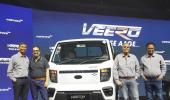'In terms of incentives, if you think about it, hybrids are a 20-year-old technology.'

As several major carmakers struggle with a slowdown in India, Mahindra and Mahindra (M&M) has defied the trend with an impressive 20.4 per cent year-on-year (Y-o-Y) jump in domestic sales, reaching 209,148 units in the April-August period.
Nalinikanth Gollagunta, CEO of M&M's Automotive Division, spoke with Deepak Patel in an interview in Delhi.
Overall passenger demand has gone down in the last few months. However, companies like M&M and Toyota are performing well. Do you see the growth momentum to continue into next year?
We have put out guidance that we will see mid-to-high teen growth in the UV (utility vehicle) segment for the year.
The festive season is expected to be a relatively good time for us.
The high base effect could come at the tail end of this year for us as well but it is not going to impact the (aforementioned) overall guidance.
How do you want to expand your retail channel?
I want to split this question into two. There is a sales retail channel, and then there is a service network channel, which is also quite critical, especially for a product like XUV 3XO (launched in April).
3XO is most likely going to be the primary car for the customer. So, the service must be done on the same day. Therefore, we are working to be present within a 5 to 7-km radius of our large customer bases in any urban area.
We will add about 150-200 outlets (retail and service) this year, increasing them by about 15 per cent year-on-year. The company currently has 1,370 sales outlets and 1,100 service workshops.

IMAGE: Nalinikanth Gollagunta.
Photograph: Kind courtesy, MahindraRise/X
Certain automakers, whose sales have grown significantly in the last few years, are now seeing their service network come under stress. Are you also seeing that stress? Or is this expansion just preempting that stress?
I wouldn't call it stress but we are starting to see service workshops' capacities getting fully utilised.
We are trying to do two to three things. First is boosting productivity and second is expanding the bay capacity within the existing workshops.
Thirdly, with the new vehicles like 3XO and Thar Roxx, the customer would not need to come to the dealership as often as his software updates would be provided over the air (remotely).
Have you assessed if you are introducing these efficiencies at service workshops, by how many per cent will the number of customer visits reduce?
Any drop in per-customer visits would be offset by higher sales volumes.
We are not necessarily looking for the overall service visits to come down because the dealer's business is also dependent on that. However, we are tracking the number of times a single customer actually visits the showroom, and we want to reduce that at a double digit (per cent) pace.
Where exactly are you seeing full utilisation of the service workshops?
Large urban areas. There are pockets in Bengaluru, Delhi, Mumbai, where you see a lot more of that starting to pop out.
It's because of the concentration of vehicles going up there. As a brand, we have truly moved a distance from where we were.
We had some urban presence, but we were largely a hinterland brand. After the launch of Thar, XUV700, and Scorpio, we've moved forward to the next level.
Our vehicles can now be seen in the toniest of neighbourhoods of Delhi and Mumbai. So, there we see (full utilisation of service workshops) and that is where the investments are going.
Does the company want to keep its entire focus on SUVs or would it like to move into new segments such as MPVs?
We shifted our strategy 4-5 years ago and we focused on what we were good at. SUVs are in our DNA, fundamentally.
The market has also moved into that space. It doesn't mean we will rule out other spaces. Certainly, we have the capabilities. The question is do we have the right to win in that segment?

The government (G20 Sherpa) has stated that it will continue with the high taxes on hybrids and low taxes on electric cars. What do you think of this issue?
What are our three long-term priorities? India has to reduce carbon emissions by 45 per cent by 2030, it has to reduce fuel import bill and it has to strongly push its exports.
EV gives us that opportunity. We are putting all our efforts into building EV manufacturing capability.
Hybrids are an intermediate solution. It's 20 per cent more fuel efficient.
So is diesel, which is 18 per cent more fuel efficient. So, if you want to give subsidies for hybrids, why not for diesel too? But the problem is, the minute you start pushing that (hybrids), the industry will react.
We will start moving investments into this (hybrids). You would lose perspective of the long term.
We are trying to build a large-scale ecosystem in EVs and that takes time.
Overall, the industry has put Rs 75,000 crore into the EV ecosystem. Therefore, we have to absolutely focus and continue to drive that (EV ecosystem) because that is the right answer.
Are you saying the government should keep its entire focus on EVs and the ecosystem around them?
In terms of incentives. If you think about it, hybrids are a 20-year-old technology.
The companies that have been working on hybrids have made those investments two decades back, and they have largely amortised them. So, they don't necessarily need a subsidy to be there.
If a customer sees a benefit from an FE (fuel emission) perspective, he is happy to pay a higher price. That's what happens in diesel today.
Electric car sales have gone down in the last 3-4 months. Hybrid car sales, in the meantime, are growing. Do these trends concern you?
Definitely, not concerned. It's too early to call any trend out of what we are. We are two per cent EV penetration at this point.
The critical thing to remember is the EVs, that have been put out there so far, are internal combustion engine (ICE) derivatives.
They are ICE vehicles, which were reworked and put out as EV vehicles, not born EVs.
Our belief is when our born EVs come out, and we have one portfolio coming out in the next couple of quarters, those truly show what an EV can deliver, and it will be a lifestyle vehicle.
Feature Presentation: Rajesh Alva/Rediff.com













 © 2025
© 2025